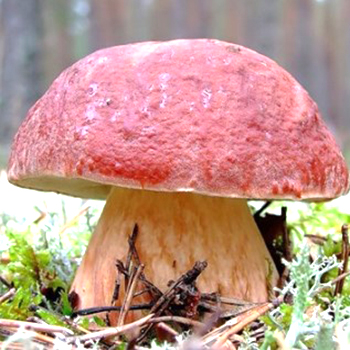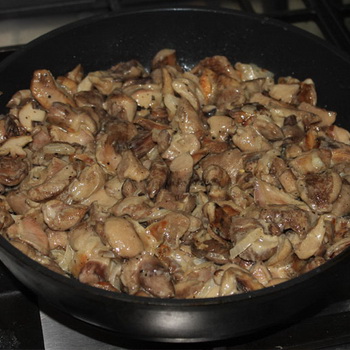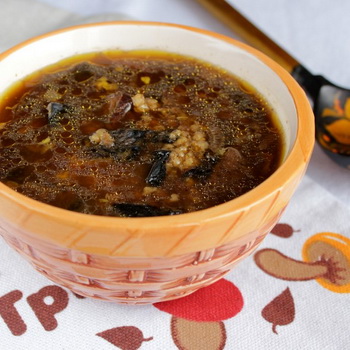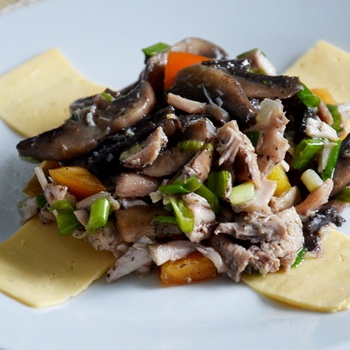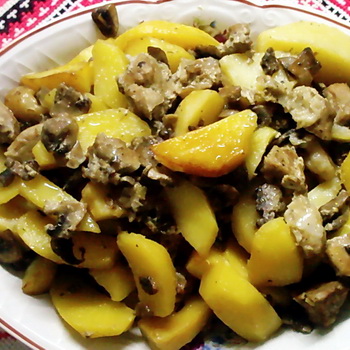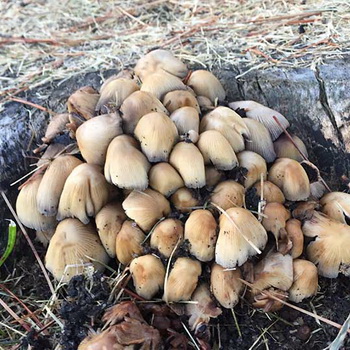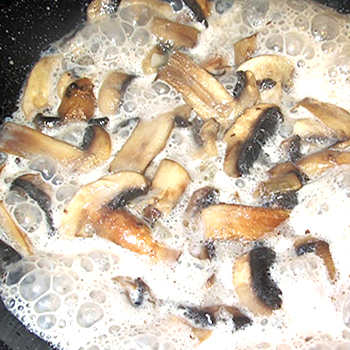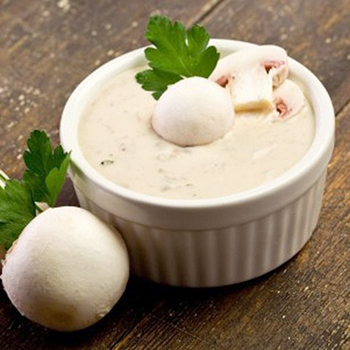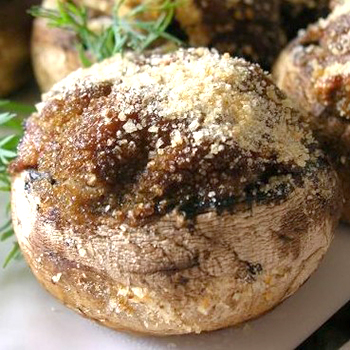How to properly handle mushrooms after harvesting: pretreatment methods before cooking
 Lovers of "quiet hunting" take one of the most worthy places in the mushroom "kingdom" for saffron milk caps. These mushrooms are worthy of respect, because they are pleasant not only to collect, but also to cook. A wide variety of dishes are prepared from these fruit bodies, including delicious preparations for the winter. It should be noted that not a single type of mushroom is subjected to as many processing methods as camelina.
Lovers of "quiet hunting" take one of the most worthy places in the mushroom "kingdom" for saffron milk caps. These mushrooms are worthy of respect, because they are pleasant not only to collect, but also to cook. A wide variety of dishes are prepared from these fruit bodies, including delicious preparations for the winter. It should be noted that not a single type of mushroom is subjected to as many processing methods as camelina.
However, in order to prepare the fruiting bodies for a rather important process - processing, they need to be properly processed. The quality of future preparations, as well as the terms of their storage, will depend on the processing of saffron milk caps.
Primary processing of saffron milk caps in the forest and at home
For quick cleaning of mushrooms at home, the best option would be the primary processing of camelina while still in the forest during harvesting. For this you need:
- Cut off dirty and spoiled areas from mushrooms with a knife, which will save time in the future.
- Remove the remnants of grass, leaves and needles from the surface of the cap, cut off the tips of the legs.


Pretreatment of saffron milk caps includes several options. It all depends on what kind of dishes will be prepared from them. Therefore, before mushrooms appear as a snack on the table, they must undergo not only cleaning from contamination, but also heat treatment.
Subsequent processing is done at home. How to properly handle mushrooms after harvesting will show a step-by-step description:


- Mushrooms are sorted out, rotten and wormy, if any, are discarded. After cutting, when interacting with air, mushrooms can slightly change their shade from red to greenish or bluish - this is a completely natural process, and there is absolutely no problem with this.
- Young and whole fruit bodies should be set aside in one direction, and cut, broken and large specimens in the other.
- If primary processing has not been carried out in the forest, then it is necessary to cut off the lower part of the leg and remove the upper layer of the plates if it is damaged.
- Spread the mushrooms in a large amount of cold water and mix well with your hands so that all the sand is removed from the plates. However, we note that if you plan to dry or freeze the mushrooms, then washing the fruiting bodies is prohibited. This can greatly affect the further storage of the main product, and it can be completely spoiled.
How to properly process mushrooms mushrooms further?


Further, each culinary specialist independently determines which recipes for processing mushrooms he will use. The processing of fruit bodies for long-term storage implies such conservation processes as pickling, salting, frying, freezing and mushroom caviar. Small and strong specimens are well suited for pickling and pickling. Large, chopped or broken mushrooms are cut into pieces and sent for another processing.
How to quickly process mushrooms before salting with cold and hot methods


For example, the most common option for harvesting mushrooms is salting them. How to properly process mushrooms before salting so that the result is a delicious canned product?


It is worth saying that mushrooms are considered one of the purest mushrooms. Although their caps are a little sticky and the grass with fallen leaves sticks to them, processing the mushrooms before cooking is not at all time-consuming work: all adhering forest debris can be easily removed from the surface of the caps. In addition, mushrooms grow mostly on sandy soils, so sand can collect between the plates, but it can also be easily removed with water.


How, then, to process mushrooms for pickling, if the cold or hot method is chosen?
- To do this, the mushrooms are cleaned of dirt and the tips of the legs are cut off.
- Broken and ugly specimens are completely discarded.
- Pour in cold water, leave for 30-40 minutes, then rinse with hands.
- Place on a large sieve or wire rack and leave to drain.
- Further, according to the chosen recipe, the mushrooms are salted or pickled.


If mushrooms are intended for dry pickling, then they should never be wetted. The mushrooms are cleaned using a damp kitchen sponge or an old medium-bristled toothbrush.
This option can be one of the most acceptable at home, as it allows you to quickly process mushrooms for subsequent processes.
How to process mushrooms for freezing: proper cleansing


There is another way to process saffron milk caps - before freezing. It should be remembered that if we are talking about freezing, then they are not washed, but cleaned in the same way as before dry salting.
How to properly process mushrooms for freezing so that they do not lose their appearance and taste?


- The surface of the caps is wiped with a damp kitchen napkin, sponge or toothbrush.
- The tips of the legs are cut off and distributed on a special tray, slightly sprinkling with non-iodized salt.
- Then they are placed in the freezer for 3-4 hours and the equipment is turned on at the lowest possible temperature.
- They take out, pour the mushrooms into plastic bags, squeeze out the air and send them back to the freezer.
Frozen mushrooms can be used to make any delicious food, including soups and sauces.
What is the best way to process saffron milk caps?


What is the best way to process mushrooms for frying so that nothing affects the gastronomic qualities of the fruit bodies? Even before frying mushrooms, the same method of cleaning and rinsing is carried out as before salting. However, some housewives prefer to do without using water in the processing of mushrooms, using dry cleaning. They believe that then more aroma and taste will remain in the fruiting bodies.


- If mushrooms are treated with water, then after rinsing they are laid out on grates so that all the liquid is glass.
- Then cut into pieces and spread in a dry hot frying pan.
- Fry over medium heat until the liquid evaporates, and then pour in vegetable oil, continuing to fry the fruit bodies until golden brown.
- If the mushrooms were peeled with a dry version, then they can be fried in oil immediately after cutting.
Option for hot processing of saffron milk caps


Many experienced housewives use another option for processing saffron milk caps - hot cleaning. This method includes preliminary cleaning of mushrooms from forest debris: needles, grass and leaf remnants.
- Next, the fruiting bodies are poured into a large container with cold water, a little salt is added and washed with hands.
- Cut off most of the leg, spread in small batches in a colander, caps down.
- They are washed under high pressure of cold water so that the remaining sand completely comes out of the mushrooms.
- In an enamel pan, let the water boil, add a pinch of citric acid and 1-2 tbsp. l. salt.
- Pour in the washed mushrooms and immediately turn off the heat, leaving them to cool completely. Then you can use the mushrooms at your discretion: marinate, salt in a hot way or fry.


You can also process saffron milk caps by boiling in several steps, changing the water each time.
- After cleaning and cutting off the tips of the stem, the mushrooms are washed and immediately introduced into boiling salted water.
- Boil for 5 minutes, drain and allow to drain a little from excess liquid.
- A new portion of water is allowed to boil and the mushrooms are introduced, boiling for another 5 minutes.
- Drain, put in a colander and leave to drain.
- Mushrooms can be boiled 2-3 times in different waters with the addition of a small amount of salt.


Many housewives use blanching in hot processing of mushrooms.
- Pre-cleaned and washed fruit bodies are distributed in a colander in small portions.
- They are introduced into boiling water for 2-3 minutes and immediately put a colander with mushrooms under a stream of cold water.Such "procedures" allow the mushrooms to remain elastic and not break. In addition, this option is used to preserve the color and aroma of mushrooms during the cold salting method.

